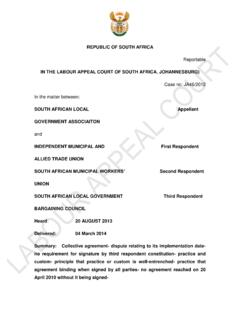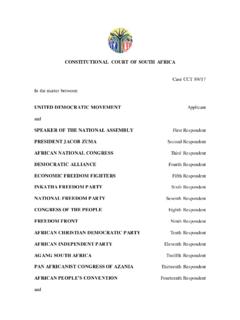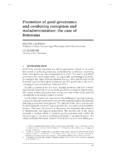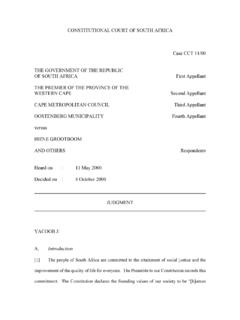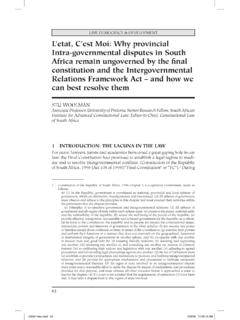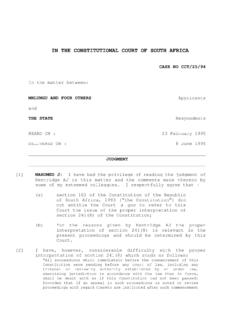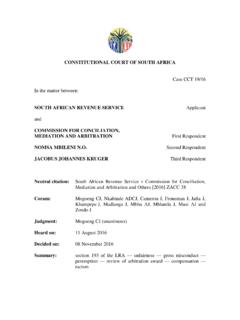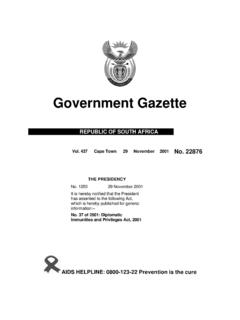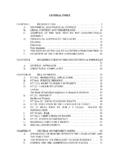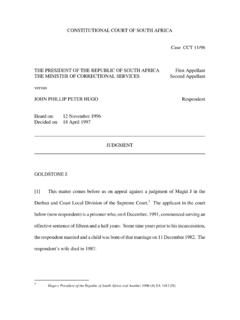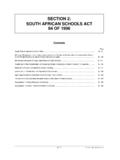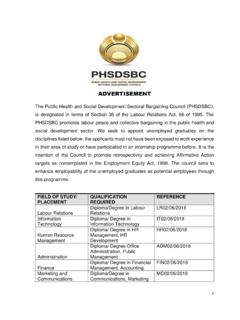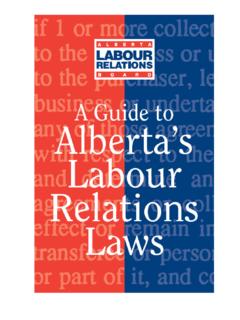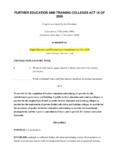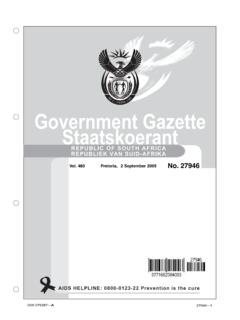Transcription of IN THE LABOUR COURT OF SOUTH AFRICA - SAFLII Home
1 IN THE LABOUR COURT OF SOUTH AFRICAHELD AT CAPE TOWNCASE NO C37/97In the matter between:MICHAEL LOUWA pplicantand GOLDEN ARROW BUS SERVICES (PTY) LTD Respondent_____JUDGMENT_____LANDMAN J Mr Louw and Mr Fredericks, both coloured males, or, as Mr Louw may 1prefer, black males in the broad sense of the term, jointly launched an application complaining that Golden Arrow Bus Services (Pty) Ltd (Golden Arrow), their employer, had committed an unfair LABOUR practice by discriminating against them on the grounds of their point in limine was taken by Golden Arrow that the dispute arose before the commencement of the LABOUR relations Act 66 of 1995 (the LRA of 1995) and that consequently this COURT did not have jurisdiction to entertain the matter.
2 A statement of agreed facts, for the purpose of the point in limine, was placed before Basson J. Basson J held that this COURT has the necessary jurisdiction to entertain a dispute concerning an unfair LABOUR practice still being perpetrated . The ruling was based on the allegation that Mr Beneke, a white warehouse supervisor receives a higher pay than the two applicants on the basis of racial characteristics and contrary to the doctrine of equal pay for work of equal value. See Louw and another v Golden Arrow Bus Services (Pty) Ltd (1998) 19 ILJ 1173 (LC). , Mr Fredericks dropped out of the picture. The statement of claim was amended as was the statement of defence. The matter proceeded to trial before me. Mr M H Cheadle, assisted by Mr A J Steenkamp, appeared for the applicant. Mr A J Freund, instructed by Mr P Farber, appeared for the applicant alleges, in his pleadings, that Golden Arrow has committed an unfair LABOUR practice in terms of item 2(1)(a) of the 7th Schedule to the LABOUR relations Act 66 of 1995 (the LRA of 1995) because (a)At all material times the work performedby the applicant and Mr Beneke was and is of equal value; alternatively(b)The difference in salaries is disproportionate to the difference in the value of the two applicant defines the legal issues as the following:1.
3 The difference in salaries constitutes direct discrimination against the applicant on the grounds of race, colour or ethnic origin because there is no justification for the The difference in salaries constitutes indirect discrimination against the applicant 3on the grounds of race, colour or ethnic origin because the respondent applied facts in its pay evaluation that had a disparate impact on black employees. These factors were performance, potential, responsibility, experience, education, attitude, skills, entry level and market By virtue of s 9(5) of the Constitution read with item 2 of Schedule 7 of the LRA of 1995, the discrimination against the applicant is discrimination against the applicant is seeks compensation in the amount of the difference between the total salary packages paid to the him and Mr Beneke for the period 11 November 1996 (the date on which the LRA of 1995 came into operation) to date of judgment and interest.
4 He also seeks an order compelling his employer to pay the difference in salaries until the job of buyer and warehouse supervisor have been evaluated by an independent job evaluator and the salaries for the jobs have been Arrow agrees that there is a wage differential between the salary paid to Mr Louw and that paid to Mr Beneke but avers that the jobs of the two men are not of equal value and that the differential is attributable to a number of considerations, 4none of which involve racial discrimination. In this judgment the terms pay, wage, salary and remuneration are used as lawA residual unfair LABOUR 2(1)(a) sets out the requirements of a residual unfair LABOUR practice. An unfair LABOUR practice is any unfair act or omission; that arises between an employee and an employer; involving unfair discrimination ; which is unfair; either directly or indirectly; against an employee; on any arbitrary ground; including, but not limited to race, gender, sex, ethnic or social origin, colour, sexual orientation, age, disability, religion, conscience, belief, political opinion, culture, language, marital status or family is necessary to comment on some of the elements constituting a residual unfair LABOUR practice.
5 I also intend to say something about Mr Freund s submission on culpability which does not feature in the wording of item 2(1)(a). item refers to an act or omission. The applicant alleges an omission. Mr Cheadle expressed it this way when I sought clarity on the applicant s cause of action: Our case will be that [Golden Arrow] inherited racial discrimination in the past and that they have done nothing about it to date. Their responsibility starts and their failure and their unfair LABOUR practice and their unfair discrimination may well be no more than not correcting an historical, inherited racial discrimination situation. unfair omission must be one involving unfair discrimination. The word involve is not one with a particularly precise meaning. The Shorter Oxford Dictionary (leaving out portions and symbols) gives the following , surround, enfold, envelop.
6 Obscure or difficult to understand; complicate, entangle. 3. Bring (a person) into a matter; embroil (a person) in trouble, difficulties, perplexity, etc. b Commit emotionally; concern closely with another, in a matter. spirally; wreathe, coil. b Join as by winding together; intertwine covertly in or under something; wrap up. b Include, contain, comprehend. c Contain implicitly; include as essential; imply, call for, entail. d Affect, concern completely; envelop, overwhelm. b Engross; occupy (a person) fully. in a charge or crime; cause or prove (a person) to be concerned. Raise (a quantity) to a power. Now rare or Involving is not the same as having the effect of discrimination as was used in the 6definition of an unfair LABOUR practice in the repealed LABOUR relations Act 28 of 1956 (the LRA of 1956).
7 The former definition of an unfair LABOUR practice, as it stood at the date of the demise of the LRA of 1956, did not expressly require intention or negligence. It would seem that it has conventionally treated by the Industrial COURT , the LABOUR Appeal COURT and the Appellate Division, now termed the Supreme COURT of Appeal, as a concept that does not require culpability. has been held that it is not necessary to show any intention to discriminate for discrimination to be established. Intention or motive of the employer may however be relevant to the remedy which the COURT may impose. See Leonard Dingler Employee Representative Council v Leonard Dingler (Pty) Ltd & others (1998) 19 ILJ 285 (LC) at 289 G H and 293 A. See also: R v Birmingham City Council, ex parte EOC [1989] IRLR 173 (HL) and James v Eastleigh Borough Council [1990] 1 IRLR 288 (HL).
8 Intention or Freund sought to persuade me that intention or motive was an integral part of a residual unfair LABOUR practice. He urged me to follow the strands of discrimination law applied in the United States. In Watson v Fort Worth Bank and Trust 487 US 977 (1988) Justice O Connor stated at 839: Several of our decisions have dealt with the evidentiary standards that apply when an individual alleges that an employer has treated that particular person less favourably than others because of the plaintiff s race, 7color, religion, sex, or natural origin. In such `disparate treatment cases, which involve `the most easily understood type of discrimination, Teamsters v United States, 431 US 324, 335, n15, 52 L Ed 2d 396, 97 S Ct 1843 (1977), the plaintiff is required to prove that the defendant had a discriminatory intent or motive.
9 Also the Developments in the Law Employment discrimination 1996 Harvard Law Review (May 1996, Vol 109 No 7) where it is stated (at 1580): There are two main types of discrimination cases: disparate treatment and disparate impact. Disparate treatment cases concern employment practices or incidents that intentionally subject people to impermissible discrimination. Disparate impact cases involve neutral employment policies, such as competency tests, that have the unintended effect of discriminating against individuals who belong to a protected class. Freund submitted that the applicant must prove that Golden Arrow had the motive or intention to discriminate. matter before me concerns an alleged residual unfair LABOUR practice. The concept of an unfair LABOUR practice was received into our LABOUR law on 1 October 1979 and has undergone several mutations (not all of them happy ones) until the repeal of the LRA of 1956 with effect from 11 November 1996.
10 The LRA of 1995 retained the essentials of the concept of an unfair LABOUR practice, termed a residual unfair LABOUR practice, in item 2(1)(a). Du Toit et al The LABOUR relations Act 28 of 1995 2nd ed 430 431 comment that:8 Discrimination on the basis of sex, race or colour was outlawed in 1981 by amendments to the previous Act and the Wage Act. Over the same period, discrimination on these and other grounds became vulnerable to attack under the unfair LABOUR practice jurisdiction of the Industrial COURT . Discrimination on the grounds of age and gender was found to be unfair under certain circumstances. It was also held that unequal pay for work of equal value is unfair. The new Act sets out to incorporate these principles into a comprehensive framework which, while specifically prohibiting certain prevalent forms of employment discrimination, can be used to strike down unfair discrimination.
